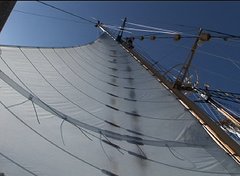“With my own hands I
had done my trick at the wheel and guided a hundred tons of wood and iron
through a few million tons of wind and waves… Life that lives is life
successful, and success is the breath of its nostrils.“ – Jack London
I woke up this morning around 5:40 in the morning to a
cheery greeting from Nicole “It’s sunny outside, the skies are blue, the winds
are blowing us strong; a great day to be on a boat!” It is a very large
departure from my alarm clock at home, a change that is greatly appreciated.
Sleeping on a boat is a challenging exercise, one that I have near mastered
from times aboard NOAA and UNOLS research vessels. You have to find a way to
wedge yourself against the side of the ship to counteract the rolls from port
to starboard and back again. Dreams tend to be more vivid on a boat, perhaps a
result of the mind incorporating the body’s motion in a dream or perhaps a
deeper level of sleep from the “gentle” rocking motion. I tend to sleep much
better on a ship once I have found my sea legs as for me it is the rocking that
provides a level of sleep that both leads me deeper and more refreshed upon
waking. Only a few days in, and the cheerful interactions with students, TAs,
and the ship’s crew keep morale high, and satisfaction strong. With 40 people
occupying 134 feet of ship, we are all a close-knit family with a common goal
of self-reflection and personal connections, while simultaneously observing our
environment with as many senses as possible, and ultimately enjoying the sea
for another day.
 |
| Our cheerful TA’s Ana, Robbie, and Natalie, and visiting scientist Kakani ready for the trip ahead. |
Most of the vessels I embark upon are entirely operated by a
crew, with much of the science collected by a dedicated science crew, which is
a large departure from life aboard the S/V Robert Seamans. Every student and
member of the ship’s crew help realize the tasks of cleaning the ship from hold
to rail every morning, making 3 meals (and 3 snacks), handling the sails,
manning the helm, and watching for ships. It brings an extra sense of both
camaraderie but also tiredness as students are working for the ship and her mates
10 hours a day. While this is not my first voyage to sea, far from it, it is my
first research trip on a sailing vessel, which provides new challenges and
accomplishments like the peak of a wave through every trough. Science takes
longer, but the team of dedicated scientists makes it very smooth and quite
easier.
“I hope to be able to
put some of the facts in a more simple and connected point of view, than that
in which they have hitherto been considered” – Sir Charles Darwin
As part of my every day job as a NOAA contractor, I have
limited interactions with students so I have particularly enjoyed seeing the
environment through multiple new perspectives. I have had students ask me to
explain the terms in an acoustic scattering equation, and have discussed with
students the forces that allow a flying fish to fly (thrust from the tail, and
lift from the wings is the short answer). We have watched a suite of seabirds
from shearwater species, Bulwar’s storm petrels, to large ocean migrants such
as the blackfooted albatross traverse the wind as waves crest and crash. Rarely
have I had so many sets of young eyes, with diverse experiences and new
perspectives on the processes shaping the wet world around them.
My role on the ship so far has been to help discuss projects
with the students, help the other visiting scientists with their projects, and
ultimately work with a few students to understand how the physical environment
structures the deep scattering layers (DSLs) in the tropical Pacific. The deep
scattering layer was first viewed as a nuisance when observed. When acoustic
soundings returned to the boat, a layer was observed between 400-600 meters in
depth and scientists weren’t sure whether this was a limitation of the gear.
Ultimately, we have realized that the DSLs (as there are often more than one
scattering layer), are a mix of organisms that live deep in the ocean during
the day to avoid being eaten and migrate to the surface to feed at night. These
organisms include fish species, shrimp, squid, jellies, and well over 50
species at a time. The DSLs also serve as critical food source in the open
ocean, where nutrients are scarce yet to date so little is known about its
ecology. I hope that with acoustics and oceanographic water column
measurements, the students and I can help explain some of the factors that
influence DSL patterns in ocean.
While only a few days in, I can already say that I hope this
will not be my last experience on Stanford @ SEA as the eagerness of the
students is infective, and the ocean is always a place of great reflection,
both of the self and of the environment compelling us all.
-Elliott Hazen
-Elliott Hazen
“Never for me the
lowered banner, never the last endeavor.” – Sir Ernest Shackelton



1 comment:
Wonderful posts... please keep them coming!
As a side note: my daughter up AND cheerful at 5:40 am? What are you guys putting in the kool-aid? ;)
Post a Comment